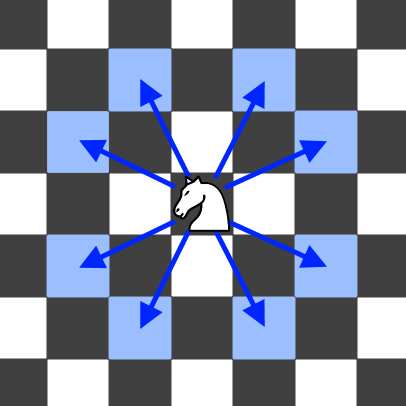题目如下:
On an
NxNchessboard, a knight starts at ther-th row andc-th column and attempts to make exactlyKmoves. The rows and columns are 0 indexed, so the top-left square is(0, 0), and the bottom-right square is(N-1, N-1).A chess knight has 8 possible moves it can make, as illustrated below. Each move is two squares in a cardinal direction, then one square in an orthogonal direction.
Each time the knight is to move, it chooses one of eight possible moves uniformly at random (even if the piece would go off the chessboard) and moves there.
The knight continues moving until it has made exactly
Kmoves or has moved off the chessboard. Return the probability that the knight remains on the board after it has stopped moving.Example:
Input: 3, 2, 0, 0 Output: 0.0625 Explanation: There are two moves (to (1,2), (2,1)) that will keep the knight on the board. From each of those positions, there are also two moves that will keep the knight on the board. The total probability the knight stays on the board is 0.0625.Note:
Nwill be between 1 and 25.Kwill be between 0 and 100.- The knight always initially starts on the board.
解题思路:本题和【leetcode】576. Out of Boundary Paths 非常相似,都是动态规划的方法。最大的不同在于本题有八个方向。主要代码几乎完全复用【leetcode】576. Out of Boundary Paths。
代码如下:
class Solution(object): def knightProbability(self, N, K, r, c): """ :type N: int :type K: int :type r: int :type c: int :rtype: float """ dp = [] for i in range(K+1): tl = [] for j in range(N): tl.append([0] * N) dp.append(tl) dp[0][r][c] = 1 direction = [(-2,1),(-1,2),(1,2),(2,1),(2,-1),(1,-2),(-1,-2),(-2,-1)] count = 0 for x in range(1,len(dp)): for y in range(len(dp[x])): for z in range(len(dp[x][y])): for (ny, nz) in direction: if (y + ny) >= 0 and (y + ny) < N and (z + nz) >= 0 and (z + nz) < N: dp[x][y][z] += dp[x - 1][y + ny][z + nz] for i in (dp[-1]): for j in i: count += j return float(count) / float(pow(8,K))
